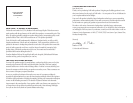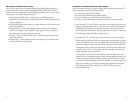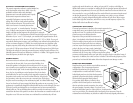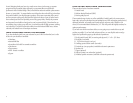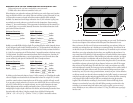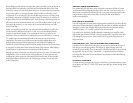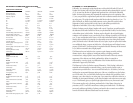
AMPLIFIER POWER REQUIREMENTS
Your speakers will work well with a variety of electronic components. As little as 50 watts
per channel will deliver adequate listening levels in most cars. If you have a noisy car or
intend to play your system at loud listening levels, more power is necessary to achieve the
best performance. More power is always better. Consult your Polk Audio dealer for
specific recommendations.
SAFE LIMITS OF OPERATION
Your Polk loudspeakers are made with the highest quality materials for years of trouble-free
performance. However, damage to loudspeakers can occur when an amplifier, regardless of
its wattage, is made to play at higher listening levels than its power can clearly produce
(usually beyond the “1 to 2 o’clock” position on the volume control).
This results in very high levels of audible distortion, originating in the amplifier, which
adds a harsh, gritty sound to the music. Contrary to popular belief, a speaker is more likely
to be damaged by trying to get too much volume from a low-powered amp than from a
high-powered one.
LOW FREQUENCY CUT - OFF FOR SYSTEMS WITH SUBWOOFERS
Now that you have a subwoofer in your system, you may want to decrease the amount of
bass going to your mid-range speakers. This will get you better midrange sound and
increase the power handling. There are two ways to roll off the bass before it gets to the mid-
range speakers. One way is to use a “bass blocker”, a capacitor placed in series with the
main input. The other route is to use an electronic crossover device which allows filtering
below 100 Hz or so.
TECHNICAL ASSISTANCE
Good luck and enjoy your new Polk EX Series II Subwoofers. If you need assistance or have
any questions, call 1-800-377-POLK (7655) between 9am and 5pm, Monday through Friday
Eastern Time.
1312
When building a ported enclosure we suggest that, whenever possible, you locate the port on
the same baffle as your subwoofer. Your port should be unobstructed both in front of and
behind it by at least 1 to 2 times the diameter of the port. If, on the inside of your enclosure,
the port comes within 1 to 2 times its diameter of the rear wall, you will need to “bend”
your port tube. If you are using PVC pipe you can either cut your port on a 45 degree angle
and rotate the cut portion by 90 degrees, and glue (using PVC cement) or you could buy a
90 degree elbow from your local hardware store. If you are using a card board port tube you
will have to use the cut and rotate method. Since you will be unable to install a “bent” port
from outside the enclosure, you can now see why we recommended leaving your baffle
board off until last.
Finally, one last thing you could do to your enclosure before installing it is to stuff it. The
primary reason for stuffing an enclosure is to “trick” the woofer into thinking that the
enclosure is larger than it actually is. You would want to do this if you build your box
smaller than the recommended size. By stuffing the box you can build the box as much as
10% smaller than recommended and still achieve the same net result as the full size
unstuffed box. The easiest way to do this is to use dacron pillow stuffing which can be
purchased from craft stores fairly inexpensively. The rule of thumb for stuffing your
enclosure is 1 pound of dacron per cubic foot. When putting the dacron into your enclosure,
do not pack it in, rather place it evenly around the inside of the enclosure. When stuffing a
ported enclosure, it is important not to obstruct the port with the dacron.
Although your new EX subwoofers were designed to work in a wide variety of enclosures and
configurations, we have included only the most popular ones. For more enclosures and
configurations, please contact your local authorized Polk Audio dealer. We hope that this
manual has helped to take the mystery out of designing an enclosure for your new Polk
Audio EX Subwoofers.




